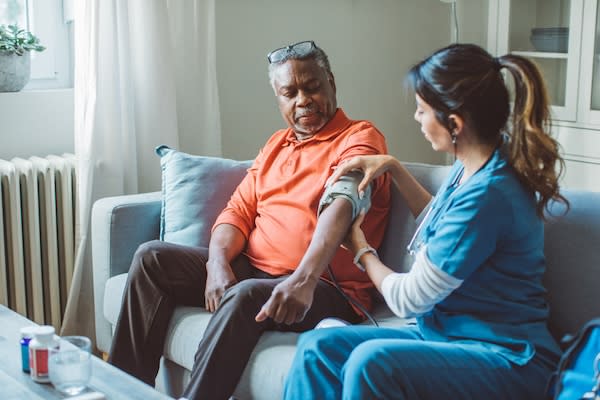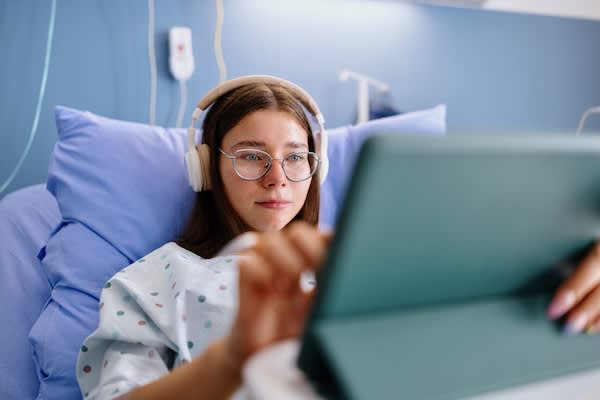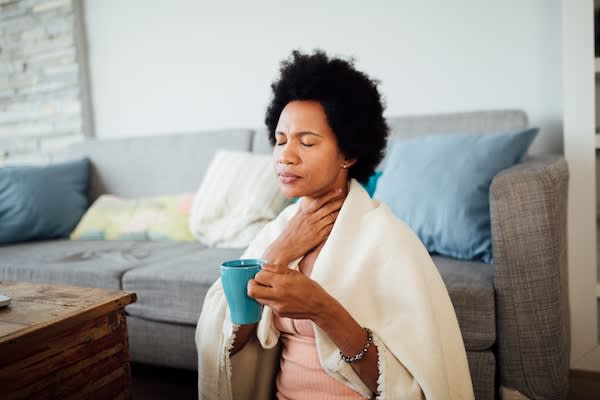Lowering hypertension in Black and Latinx communities

[5 MIN READ]
In this article:
-
American Black and Latinx people have higher rates of uncontrolled hypertension, or high blood pressure, than White people do.
-
Researchers have learned that part of the reason for this disparity is because people in underserved communities may feel uncomfortable talking with their primary care provider about health issues.
-
Providence is piloting a community health care worker program to try to close the gap in ethnic disparities.
Hypertension, or high blood pressure, is called the “silent killer” for a reason: While it usually doesn’t cause any symptoms by itself, it can greatly increase your risk factor for heart failure, a heart attack, stroke and a host of other medical problems.
Researchers have long noted that Black and Latinx adults have higher rates of hypertension than White adults do. A 2023 study found that among people with high blood pressure, Black people are 10% less likely to have it under control than their White counterparts.
Sonja Maddox, M.D., a Providence primary care physician, health equity advisor and clinical lead for Pacific Medical Centers in the greater Seattle area, and Karla Gomez, manager for health equity for Providence’s South Division, spoke on a recent Culture of Health podcast episode about why hypertension is such a problem among these communities, and what Providence is doing to close the gap.
Addressing health disparities
According to Dr. Maddox, before 2020, Providence leaders had not analyzed their patients based on race and ethnicity. “And so, when we started looking, lo and behold, we found that not all of our patients were being taken care of as well,” she says. “That’s when we started forming our health equity team, and one of the very first health initiatives we started working on was hypertension.”
The team started looking at Black adult patients’ care in 2021 and expanded its focus to include other people of color, such Latinx patients, in 2023. “Before we started in 2021, 63% of our black patients did not have their blood pressure controlled,” she says. “At the end of May 2024, we were at 68%. So, by percent improvement we’ve been doing great. But it's still lower than we want.”
Health challenges for Black and Latinx communities
As Providence doctors examined data from recent years, they thought the disparity may have been because Black and Latinx patients didn’t fill their prescriptions as much as White patients did. But they were wrong. “Actually, the medication fill rates were exactly the same whether or not patients were White or Black,” says Dr. Maddox. “So, it’s not that patients are not doing what we’re asking them to do.”
Instead, she says, doctors found that elevated blood pressure was not always addressed by the caregiver. In many cases, it’s because patients were dismissing their hypertension as just “having a bad day,” or anxious about sharing all of their health issues with their provider.
“We have talked a lot about historical differences in care and why people are fearful to go to the doctor,” Dr. Maddox says. “But those things happen in present day as well. I see it a lot — they are scared when they come and not sure what to expect or who to trust.”
Another challenge among Black and Latinx communities, says Gomez, is that many people don’t know where to start when they have a medical problem. “A lot of them don’t know that they need a primary care physician — especially people who are the first generation in the United States,” she says. “They wait until the last minute to go to the doctor until something critical happens, versus really having that knowledge of why it’s important to be aware of preventive health.”
Even when patients in underserved communities learn they have hypertension, they don’t always have the means to address it. They might live in a “food desert,” where there is only fast food available, and they have limited access to fresh fruits, vegetables and other healthy foods.
Community health care worker program at Providence
To help Black, Latinx and other underserved communities receive quality health care and manage chronic disease, Providence has started piloting a community health care worker program. The worker helps patients get the medications they need from the pharmacist, answers any questions they may have and connects them to transportation, food and resources in the community.
“I’m really proud of how this program works,” says Dr. Maddox. “The community health workers reach out to patients whose blood pressure may not be controlled, and see what things they need to help reach their health care goals. This helps them feel like they’re not lost in this big system and that their doctor does care about their health.”
Each of the community health care workers is from a specific demographic that Providence is trying to reach. “We want to make sure it’s someone who understands the community they’re working with,” says Gomez. “Patients are going to see that individual both in their community and when they come in to the clinic, which allows us to bridge that gap.”
Hypertension is a serious problem that can have serious consequences, but providers throughout Providence are working to make sure they can reach everyone, in every ethnic minority, to help them get healthy.
Contributing caregivers

Sonja Maddox, M.D., is a Providence primary care physician, health equity advisor and clinical lead for Pacific Medical Centers in the greater Seattle area.
Karla Gomez is the manager for health equity for Providence’s South Division.
Find a doctor
If you are looking for a Providence primary care provider, you can search for one in our provider directory.
Download the Providence app
We’re with you, wherever you are. Make Providence’s app your personalized connection to your health. Schedule appointments, conduct virtual visits, message your doctor, view your health records and more. Learn more and download the app.
Related resources
Providing support for Black mothers
Five tips to lower blood pressure without medication
Mobile health clinic offers free care
This information is not intended as a substitute for professional medical care. Always follow your health care professional’s instructions.



